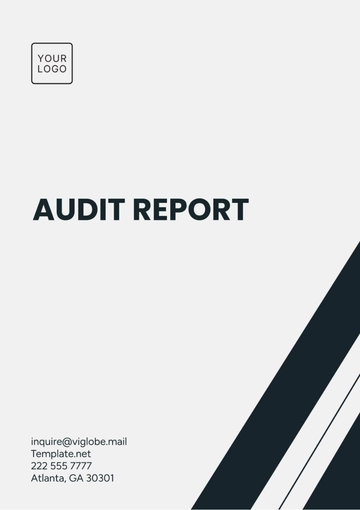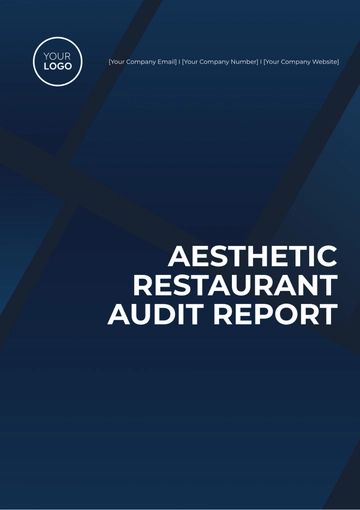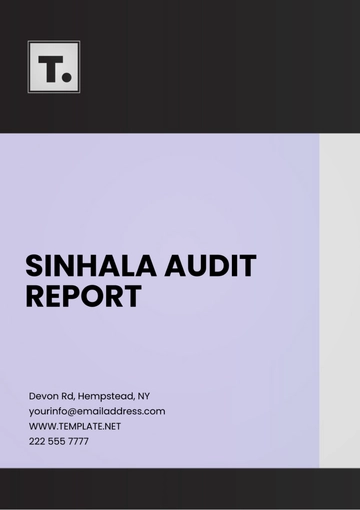Free Church Compliance Report

I. Introduction
A. Purpose of the Report
Documentation of Compliance Activities: The primary purpose of this Church Compliance Report is to document the compliance activities carried out by [Your Company Name] to ensure adherence to all applicable regulations and standards. This includes a detailed analysis of the church's policies, procedures, and practices.
Reporting Compliance Status: This report also aims to provide a comprehensive overview of the current compliance status of [Your Company Name]. It identifies areas of compliance, partial compliance, and non-compliance, offering insights and recommendations for improvement.
B. Scope of the Report
Regulatory Framework: The scope of this report encompasses all relevant regulatory frameworks, including local, state, and federal regulations that govern the operations of churches. This ensures a holistic approach to compliance assessment.
Internal Policies and Procedures: Additionally, this report covers internal policies and procedures to evaluate their alignment with regulatory requirements. This includes an assessment of governance, financial management, and operational practices.
II. Governance Compliance
The following table outlines the compliance status of governance practices at [Your Company Name]:
No. | Aspect | Status |
|---|---|---|
1 | Board Meetings | Compliant |
2 | Conflict of Interest | Partially Compliant |
3 | Policy Documentation | Non-Compliant |
4 | Transparency Practices | Compliant |
A. Board Meetings
Frequency and Documentation: The church holds regular board meetings, ensuring decisions are documented and aligned with regulatory standards. Meetings are conducted monthly with detailed minutes recorded and reviewed.
Attendance and Participation: Board members actively participate in meetings, contributing to effective governance. Attendance records indicate high engagement, with over 90% participation rate.
B. Conflict of Interest
Policy Implementation: The church has implemented a conflict of interest policy, but there are areas needing improvement. While board members disclose potential conflicts, there is a need for stricter enforcement and regular reviews.
Training and Awareness: Training sessions on conflict of interest policies have been conducted, but not all members have attended. Enhancing awareness and compliance through mandatory training sessions is recommended.
C. Policy Documentation
Comprehensive Policies: Policy documentation is currently lacking, with several key policies either outdated or missing. This non-compliance poses a risk to effective governance and regulatory adherence.
Action Plan: Developing a comprehensive policy framework, including regular reviews and updates, is crucial. Assigning a dedicated team for policy management can ensure timely updates and adherence.
D. Transparency Practices
Financial Transparency: The church maintains transparency in financial reporting, with regular audits and public disclosures. Financial statements are available to members, ensuring accountability.
Operational Transparency: Operational decisions and practices are communicated openly to the congregation, fostering trust and engagement. Regular newsletters and meetings keep members informed.
Further efforts to enhance governance practices, especially in policy documentation and conflict of interest management, will strengthen compliance and ensure effective church operations.
III. Financial Compliance
The following table outlines the compliance status of financial practices at [Your Company Name]:
No. | Aspect | Status |
|---|---|---|
1 | Budgeting | Compliant |
2 | Financial Reporting | Partially Compliant |
3 | Auditing | Compliant |
4 | Donations Management | Non-Compliant |
A. Budgeting
Annual Budgeting Process: The church follows a structured annual budgeting process, ensuring funds are allocated appropriately to various activities and programs. This process involves input from multiple stakeholders to ensure accuracy and transparency.
Monitoring and Adjustments: Budget performance is monitored regularly, with adjustments made as necessary to align with changing circumstances. This proactive approach helps maintain financial stability and compliance.
B. Financial Reporting
Timely Reporting: Financial reports are generated regularly, but there are instances of delayed submissions. Ensuring timely reporting is essential for compliance and maintaining donor trust.
Accuracy and Completeness: While financial statements are generally accurate, occasional discrepancies have been noted. Implementing stricter review processes can enhance the accuracy and reliability of reports.
C. Auditing
Regular Audits: The church conducts regular audits to ensure financial practices are compliant and transparent. These audits are performed by independent auditors, providing an objective assessment of financial health.
Audit Follow-ups: Follow-up actions on audit findings are promptly addressed, demonstrating a commitment to continuous improvement. This practice helps in maintaining high standards of financial compliance.
D. Donations Management
Documentation and Tracking: There are gaps in the documentation and tracking of donations, leading to non-compliance. Establishing a robust system for recording and acknowledging donations is necessary.
Transparency with Donors: Providing clear reports to donors on how their contributions are used is crucial for building trust. Enhancing transparency in donations management will improve compliance and donor relations.
Strengthening financial reporting and donations management practices will enhance overall financial compliance and ensure the church meets regulatory requirements.
IV. Operational Compliance
The following table outlines the compliance status of operational practices at [Your Company Name]:
No. | Aspect | Status |
|---|---|---|
1 | Health and Safety | Compliant |
2 | Facility Maintenance | Partially Compliant |
3 | Emergency Preparedness | Non-Compliant |
4 | Volunteer Management | Compliant |
A. Health and Safety
Policies and Procedures: The church has established comprehensive health and safety policies, ensuring a safe environment for all members. These policies are regularly reviewed and updated to comply with regulatory standards.
Training and Awareness: Health and safety training sessions are conducted for staff and volunteers, promoting a culture of safety. Regular drills and workshops enhance awareness and preparedness.
B. Facility Maintenance
Maintenance Schedule: The church has a maintenance schedule, but adherence to this schedule is inconsistent. Regular inspections and timely repairs are necessary to ensure compliance and prevent safety hazards.
Upkeep and Repairs: While minor repairs are addressed promptly, major maintenance projects are often delayed due to budget constraints. Allocating sufficient funds for facility maintenance is essential for compliance.
C. Emergency Preparedness
Emergency Plans: The church lacks comprehensive emergency preparedness plans, leading to non-compliance. Developing and implementing detailed emergency response plans is critical for ensuring the safety of all members.
Training and Drills: Regular training and drills for emergency situations are not conducted consistently. Enhancing preparedness through regular drills and updated training programs will improve compliance.
D. Volunteer Management
Recruitment and Training: The church has effective volunteer recruitment and training processes, ensuring volunteers are well-prepared for their roles. This includes background checks and orientation sessions.
Supervision and Support: Volunteers receive adequate supervision and support, fostering a positive and compliant working environment. Regular feedback and recognition programs enhance volunteer engagement and retention.
Addressing gaps in facility maintenance and emergency preparedness will strengthen operational compliance and ensure a safe and efficient environment for all church activities.
V. Human Resources Compliance
The following table outlines the compliance status of human resources practices at [Your Company Name]:
No. | Aspect | Status |
|---|---|---|
1 | Hiring Practices | Compliant |
2 | Employee Training | Partially Compliant |
3 | Performance Management | Compliant |
4 | Equal Opportunity | Non-Compliant |
A. Hiring Practices
Fair and Transparent: The church follows fair and transparent hiring practices, ensuring equal opportunity for all applicants. This includes clear job descriptions, structured interviews, and unbiased selection criteria.
Background Checks: Comprehensive background checks are conducted for all potential employees, ensuring the safety and integrity of the church community. This practice is in line with regulatory standards.
B. Employee Training
Onboarding Programs: While onboarding programs are in place, they need to be more comprehensive. Enhancing the onboarding process with detailed training on policies, procedures, and expectations will improve compliance.
Ongoing Training: Regular training sessions are conducted, but attendance is inconsistent. Implementing mandatory training programs with strict attendance tracking will ensure all employees are adequately trained.
C. Performance Management
Regular Reviews: The church conducts regular performance reviews, providing constructive feedback and development opportunities for employees. This practice helps in maintaining high performance standards and compliance.
Clear Objectives: Performance objectives are clearly defined and communicated to employees, aligning their efforts with the church's mission and goals. This clarity fosters accountability and compliance.
D. Equal Opportunity
Policy Implementation: The church's equal opportunity policy is not fully implemented, leading to non-compliance. Ensuring strict adherence to this policy is crucial for maintaining a fair and inclusive work environment.
Diversity Initiatives: Initiatives to promote diversity and inclusion are lacking. Developing and implementing programs to foster diversity will enhance compliance and create a more inclusive community.
Improving employee training and equal opportunity practices will enhance human resources compliance and support a positive and inclusive church environment.
VI. Data Privacy Compliance
The following table outlines the compliance status of data privacy practices at [Your Company Name]:
No. | Aspect | Status |
|---|---|---|
1 | Data Collection | Compliant |
2 | Data Storage | Partially Compliant |
3 | Data Access | Non-Compliant |
4 | Data Sharing | Compliant |
A. Data Collection
Consent and Transparency: The church collects data with proper consent from members and adheres to transparency principles. This practice ensures compliance with data privacy regulations and builds trust within the community.
Data Minimization: Only necessary data is collected, reducing the risk of data breaches and ensuring compliance. This approach aligns with the principle of data minimization and enhances data security.
B. Data Storage
Secure Storage Systems: While the church uses secure storage systems, there are areas needing improvement. Enhancing encryption and access controls will strengthen data security and compliance.
Regular Audits: Regular audits of data storage practices are conducted, but findings are not always addressed promptly. Implementing a more rigorous follow-up process will ensure compliance and data integrity.
C. Data Access
Access Controls: The church lacks strict access controls, leading to non-compliance. Implementing robust access control measures, including user authentication and authorization, is essential for data security.
Training and Awareness: Training on data access policies is insufficient. Conducting regular training sessions and awareness programs will improve compliance and protect sensitive data.
D. Data Sharing
Sharing Policies: The church has clear data sharing policies, ensuring data is shared responsibly and in compliance with regulations. These policies include guidelines for sharing data with third parties.
Member Consent: Consent is obtained before sharing member data, maintaining transparency and compliance. This practice ensures members are aware of how their data is used and shared.
Strengthening data storage and access practices will enhance overall data privacy compliance and protect sensitive information.
VII. Environmental Compliance
The following table outlines the compliance status of environmental practices at [Your Company Name]:
No. | Aspect | Status |
|---|---|---|
1 | Waste Management | Compliant |
2 | Energy Efficiency | Partially Compliant |
3 | Water Conservation | Compliant |
4 | Environmental Awareness | Non-Compliant |
A. Waste Management
Recycling Programs: The church has implemented effective recycling programs, ensuring proper disposal of waste materials. This practice reduces environmental impact and aligns with regulatory standards.
Hazardous Waste: Hazardous waste is managed and disposed of according to regulations, minimizing risks to health and the environment. Regular training on hazardous waste management is conducted.
B. Energy Efficiency
Energy Audits: The church conducts regular energy audits, but there is room for improvement. Implementing recommendations from these audits will enhance energy efficiency and compliance.
Sustainable Practices: Efforts to incorporate sustainable practices, such as using energy-efficient appliances and lighting, are ongoing. Increasing the adoption of sustainable practices will improve compliance.
C. Water Conservation
Water Usage Monitoring: Water usage is monitored and managed effectively, ensuring compliance with conservation regulations. This practice helps in reducing water consumption and environmental impact.
Conservation Initiatives: The church has implemented water conservation initiatives, such as low-flow fixtures and rainwater harvesting. These initiatives contribute to compliance and sustainability goals.
D. Environmental Awareness
Awareness Programs: Environmental awareness programs are lacking, leading to non-compliance. Developing and implementing programs to educate members on environmental issues is crucial.
Community Involvement: Encouraging community involvement in environmental initiatives will enhance compliance and foster a culture of sustainability. Partnering with local organizations can support these efforts.
Enhancing energy efficiency and environmental awareness practices will strengthen overall environmental compliance and contribute to sustainability goals.
VIII. Recommendations
A. Governance
Policy Development: Develop comprehensive policies for all aspects of governance, including conflict of interest and transparency practices. Regularly review and update these policies to ensure compliance.
Training Programs: Implement mandatory training programs for board members on governance best practices. This will enhance their understanding of compliance requirements and improve governance standards.
B. Financial Practices
Enhanced Reporting: Ensure timely and accurate financial reporting by implementing stricter review processes. This will improve transparency and compliance with regulatory standards.
Donations Management: Establish a robust system for tracking and managing donations. Enhance transparency with donors by providing regular reports on how their contributions are used.
C. Operational Practices
Facility Maintenance: Allocate sufficient funds for regular facility maintenance. Ensure timely repairs and adherence to the maintenance schedule to prevent safety hazards and ensure compliance.
Emergency Preparedness: Develop and implement comprehensive emergency preparedness plans. Conduct regular training and drills to enhance preparedness and compliance.
D. Human Resources
Employee Training: Enhance onboarding and ongoing training programs to ensure all employees are adequately trained on policies and procedures. Implement mandatory training with strict attendance tracking.
Equal Opportunity: Ensure strict adherence to the equal opportunity policy. Develop diversity initiatives to promote an inclusive work environment and improve compliance.
E. Data Privacy
Access Controls: Implement robust access control measures to enhance data security. Conduct regular training on data access policies to improve compliance and protect sensitive information.
Storage Enhancements: Enhance data storage practices by improving encryption and access controls. Implement a rigorous follow-up process for audit findings to ensure compliance.
F. Environmental Practices
Energy Efficiency: Implement recommendations from energy audits to enhance energy efficiency. Increase the adoption of sustainable practices to improve compliance.
Environmental Awareness: Develop and implement environmental awareness programs. Encourage community involvement in environmental initiatives to foster a culture of sustainability.
IX. Conclusion
This Church Compliance Report has highlighted areas of strength and areas needing improvement within [Your Company Name]. While the church demonstrates strong compliance in governance, financial practices, and operational practices, there are gaps in policy documentation, donations management, and emergency preparedness that need to be addressed. Additionally, improvements in employee training, data privacy, and environmental awareness will enhance overall compliance.
[Your Company Name] is committed to continuous improvement and ensuring full compliance with all regulatory standards. By implementing the recommendations outlined in this report, the church will strengthen its compliance practices and foster a safe, inclusive, and sustainable environment for all members. The church's leadership will work diligently to address the identified gaps and ensure ongoing compliance through regular reviews and updates of policies and practices.
- 100% Customizable, free editor
- Access 1 Million+ Templates, photo’s & graphics
- Download or share as a template
- Click and replace photos, graphics, text, backgrounds
- Resize, crop, AI write & more
- Access advanced editor
Ensure adherence to regulations with the Church Compliance Report Template! Available only here on Template.net, this template is editable and customizable to fit your church’s compliance reporting requirements. Make use of the integrated AI Editor Tool to accurately document compliance activities, helping maintain transparency and accountability! Showcase your compliance now!
You may also like
- Sales Report
- Daily Report
- Project Report
- Business Report
- Weekly Report
- Incident Report
- Annual Report
- Report Layout
- Report Design
- Progress Report
- Marketing Report
- Company Report
- Monthly Report
- Audit Report
- Status Report
- School Report
- Reports Hr
- Management Report
- Project Status Report
- Handover Report
- Health And Safety Report
- Restaurant Report
- Construction Report
- Research Report
- Evaluation Report
- Investigation Report
- Employee Report
- Advertising Report
- Weekly Status Report
- Project Management Report
- Finance Report
- Service Report
- Technical Report
- Meeting Report
- Quarterly Report
- Inspection Report
- Medical Report
- Test Report
- Summary Report
- Inventory Report
- Valuation Report
- Operations Report
- Payroll Report
- Training Report
- Job Report
- Case Report
- Performance Report
- Board Report
- Internal Audit Report
- Student Report
- Monthly Management Report
- Small Business Report
- Accident Report
- Call Center Report
- Activity Report
- IT and Software Report
- Internship Report
- Visit Report
- Product Report
- Book Report
- Property Report
- Recruitment Report
- University Report
- Event Report
- SEO Report
- Conference Report
- Narrative Report
- Nursing Home Report
- Preschool Report
- Call Report
- Customer Report
- Employee Incident Report
- Accomplishment Report
- Social Media Report
- Work From Home Report
- Security Report
- Damage Report
- Quality Report
- Internal Report
- Nurse Report
- Real Estate Report
- Hotel Report
- Equipment Report
- Credit Report
- Field Report
- Non Profit Report
- Maintenance Report
- News Report
- Survey Report
- Executive Report
- Law Firm Report
- Advertising Agency Report
- Interior Design Report
- Travel Agency Report
- Stock Report
- Salon Report
- Bug Report
- Workplace Report
- Action Report
- Investor Report
- Cleaning Services Report
- Consulting Report
- Freelancer Report
- Site Visit Report
- Trip Report
- Classroom Observation Report
- Vehicle Report
- Final Report
- Software Report





























